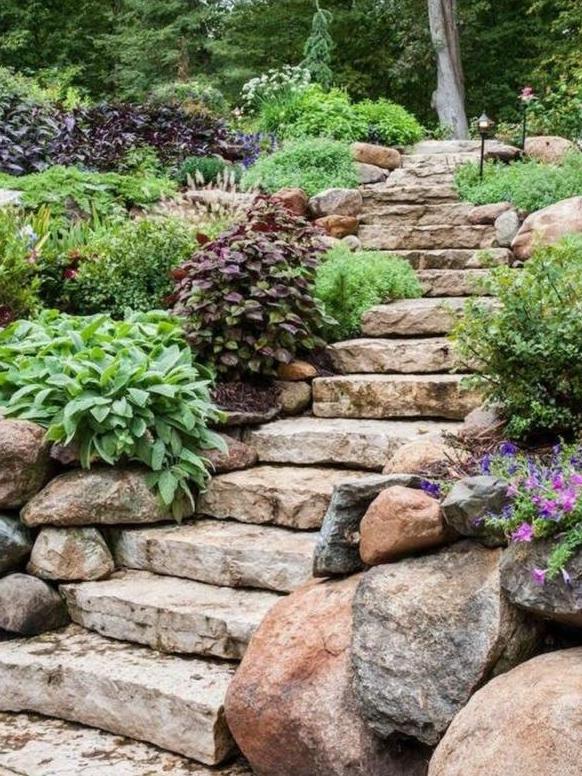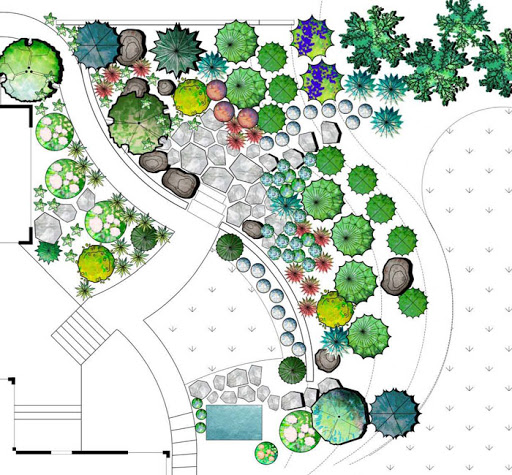The many balancing roles of a Landscape Architect

“The world is moving into a phase when landscape design may well be recognised as the most comprehensive of the arts.” – Geoffrey Jellicoe
(Image – Stone steps and himalayan plant species in a hill slope architecture project used as a bridge across different terrace contour levels. Sriparna Saha is an architect working on several landscape architectural and garden design projects in the Uttarakhand Himalayan region.)
Landscape Architect – Establishing Balance within Context
The landscape is where all living things gather. Landscape architects need to shape and balance the physical infrastructure and the natural habitat.
The context for every structure and daily life activities is provided by the landscape. While designing, it is imperative that the context is given due importance. Context can again have social, economic, cultural, environmental and historical perspectives and can have many more additional connections. Clearly, there has to be a harmony between the building exterior, the interior and the building context for all this to come together as a unique whole.
For any built up structure to be sustainable and not be out of sync, the topography, the surroundings and the situation require deep study. This is the core essence of a successful landscape architecture practice.
‘The Architectures’
The discipline of landscape architecture is only a few hundred years old. However, the informal practice of it is not entirely new.
Landscape architecture is flanked by adjacent disciplines which can be broadly referred to as ‘the architectures’. These adjacent lines of architectural practice are building architecture, interior design, urban design and planning. There are also common areas of intersection with civil engineering and structural engineering.
In landscape design and architecture, it is important to develop the capability of looking at all aspects holistically and contextually. All elements in a landscape are interconnected. The exterior environment is the fabric. In the case of any single element being altered, every other element and the entire fabric also get impacted. This perspective helps us to understand all the interconnections at a deeper level.
The Process Involved in the Landscape Architecture Practice
The practice starts with the objective of identifying and enumerating all the needed and possible functions. It needs the architect to study sites in great detail and visualize how these can effectively fulfilled by the site. The functions can be for the present and the future. This clarity and comprehensibility is difficult to achieve in just a single visit. As is evident, multiple visits and observations during different seasons of the year and also, different times of the day may be needed.
Further, effective documentation and subsequent reflections are needed to come up with the best approach and the best fit. With multiple elements and diverse disciplines to work with, landscape architecture strives to accommodate all the needed functions – human and natural. This is what makes this role complex and challenging.
Needing both logical and creative abilties
To visualize and conceptualize an effective landscape architecture, we need a combination of both art and science. Again, this process needs an amalgamation of both logical and creative abilities. It needs the broad thinking and big picture thinking abilities in addition to getting down to the micro-level. It is a classic case where the architect needs strong zoom in and zoom out thinking and visualizing capabilities.
A Natural Leader and a Team Worker
Also, the practice needs natural leadership capabilities to be able to lead large teams with people who have diverse knowledge and capabilities. The approach needs developing a comprehensive insight of both natural and built-up systems.
Starting with topography, natural systems can include soils, geology, it can go on to cover ecology, plants, animals and further include climate and hydrology. Built up systems largely need knowledge of structures and how they are built. No wonder that the landscape architect has to interface with experts from multiple disciplines. It is but natural that architect has the ability to intuitively strike the right balance between the team members.
Though not highlighted often, this practice needs finely honed instincts and capabilities to be able to leverage the enormous scope of work and activities possible to the advantage of the project.
Multiple Roles Within One Super Role
As is required by the nature and the scope of the project, a landscape architect has to take on the role of a landscape designer, landscape planner, project manager, and urban designer. This can create an extremely diverse, rich, and interesting professional life full of enormous learning opportunities. A talented architect will convert this challenge into an area of strength.
The practice of landscape architecture needs creative, talented and open-minded people who can further develop into personalities with multi-dimensional capabilities and deliver immense value to their projects and the environment, in general.
In the near future, I shall be writing on the following General Blog Topics: Landscape designer -Software – Garden designer – Park architect -Hardscape -Softscape – Xeriscape – Himalayan plants- Buransh (Rhododendron Arboreum)
And, also on the following specific areas: Case studies – Famous landscape architects – English gardens
My Homestay Architecture Blog : Pahadi Ghar Homestays; My Home Renovation Blog : A Case of Home Renovation and Remodeling ; My Travel Blogs : My trips to the Himalayas –Uttarakhand Glacier Burst – My earlier travel blogs
About Sriparna Saha

Sriparna Saha is an architect specializing in hill slope architecture projects in the Himalayan region.
Because of the diversity of the Himalayan terrain, the landscape architecture projects have been challenging and extremely fulfilling. Her evolution as a Himalayan landscape architect by putting theory to practice has been anything but simple and straight-forward.
During this process, she has worked with several experts and also informal local practitioners to develop a strong knowledge of the local plant life. Being an avid traveler and one who enjoys interacting with people on the ground, she has thoroughly enjoyed this process of learning and her evolution into a Himalayan landscape architect.
She is based out of Dehradun, Uttarakhand, INDIA.
Architect Sriparna Saha – Detailed Profile

